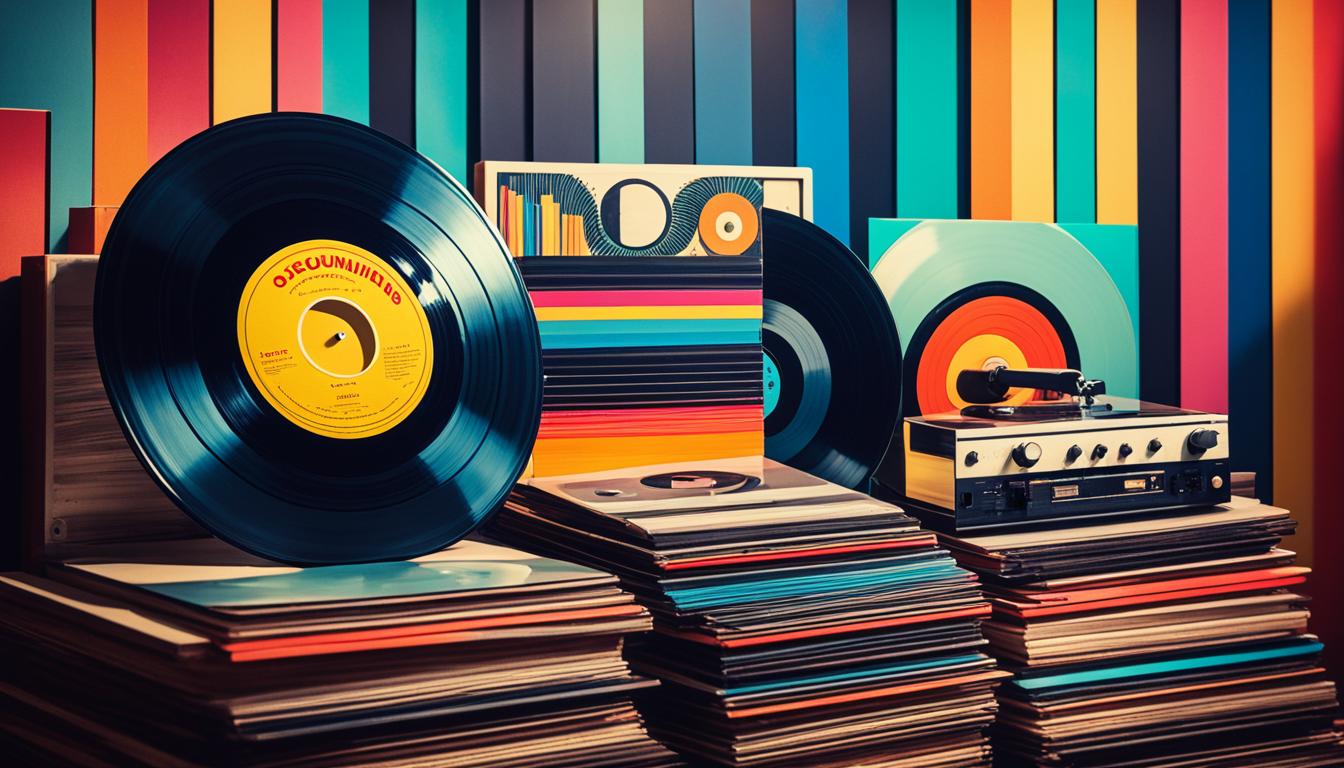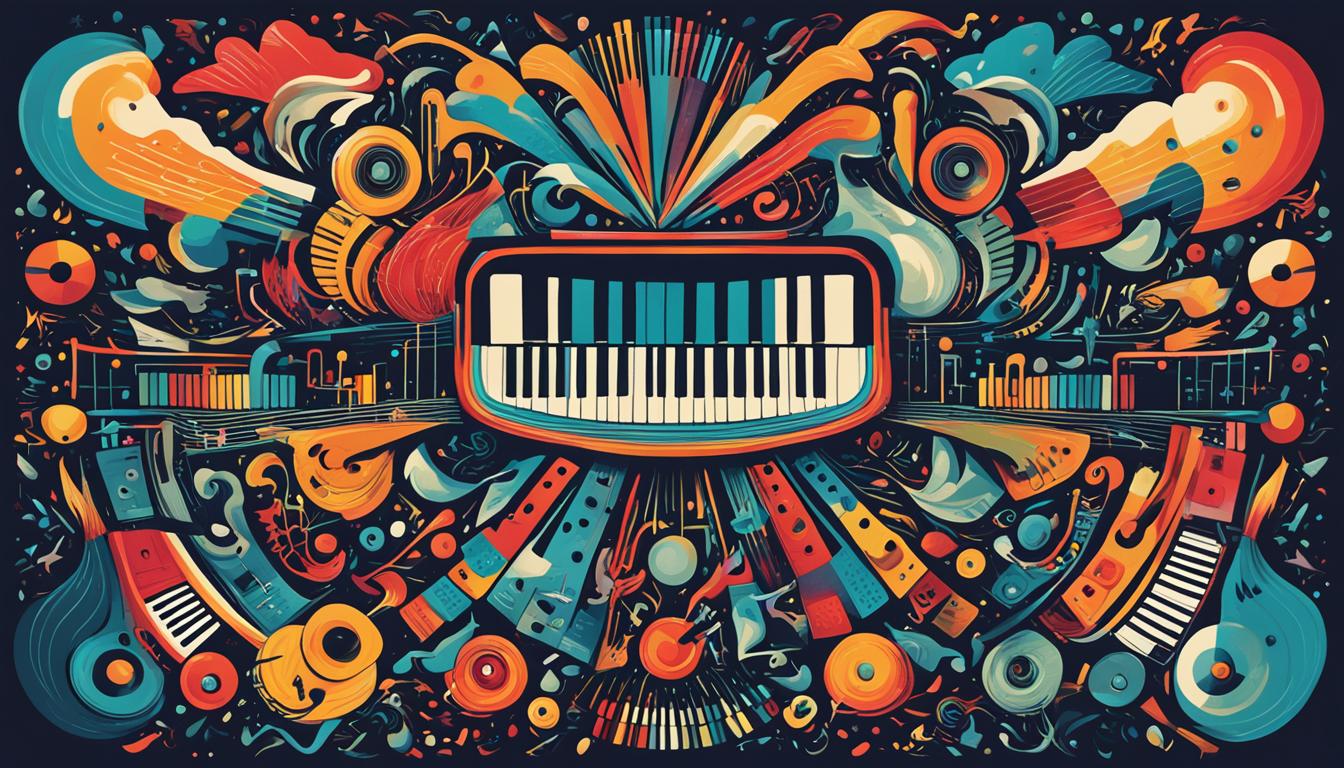Welcome to a world where music genres and artists come together to create a harmonious tapestry of sound. From the timeless melodies of classical compositions to the cutting-edge beats of contemporary music, the diverse musical landscape offers something for every listener. In this article, I will delve into the captivating world of music genres and artists, exploring popular trends, diverse styles, and the ever-evolving music industry.
As music aficionados, we all have our favorite genres that resonate with us on a personal level. Whether it’s the soothing rhythms of jazz, the infectious hooks of pop, or the soul-stirring symphonies of classical music, iconic genres have shaped the rich history of music. But it doesn’t stop there. With emerging music artists constantly pushing boundaries, new genres are constantly emerging, showcasing the limitless possibilities of musical expression.
Exploring music genres and artists goes beyond mere entertainment. It is an opportunity to gain insights into different cultures, connect with emotions, and even find therapeutic benefits. Music has the power to uplift our spirits, evoke deep emotions, and transport us to different eras or places. It serves as a universal language that brings people together, transcending borders and barriers.
Throughout this article, I will unveil the captivating stories behind some of the most iconic music genres, the influential artists who have shaped the musical landscape, and the trends that continue to define contemporary music. Additionally, we will explore the changing revenue models for artists in the digital age, delve into the therapeutic benefits of music, and discover the art of songwriting in different genres.
So join me on this musical journey as we celebrate the expertise and mastery of musicians across various genres. From the classical maestros to the rising stars, we will shine a spotlight on the individuals who continue to push the boundaries of musical expression and inspire us with their talent.
Key Takeaways:
- Music genres and artists offer a diverse and rich tapestry of sound for listeners.
- Iconic genres and artists have shaped the history and culture of music.
- Contemporary music trends continue to push boundaries and fuse old and new styles.
- Listening to music has therapeutic benefits and can evoke emotions.
- The art of songwriting varies across different genres and allows for unique expressions.
Classical Music: A Pillar of Cultural Heritage
The Influence of Iconic Composers
Classical music stands as a cornerstone of cultural heritage, captivating audiences for centuries with its timeless beauty and profound emotional depth. One cannot delve into classical music without acknowledging the profound influence of iconic composers. Wolfgang Amadeus Mozart, Ludwig van Beethoven, and Johann Sebastian Bach are just a few names that have left an indelible mark on the genre.
These legendary composers pushed the boundaries of music, transforming classical compositions into masterful works of art. Their melodies continue to resonate with listeners today, transcending time and space. From the elegance of Mozart’s symphonies to the revolutionary spirit of Beethoven’s symphonies, their creations paved the way for future composers and shaped the evolution of classical music.
Evolution and Education
As classical music evolved, different styles emerged, helping to weave a rich tapestry of sound. From the Baroque period to the Romantic era, each era brought forth new compositional techniques and artistic expressions. The symphony, concerto, and sonata forms became prominent structures, allowing composers to showcase their skills and convey complex emotions.
Moreover, classical music plays a vital role in education, serving as a foundation for music appreciation and understanding. It introduces students to the elements of music, such as melody, harmony, rhythm, and form. Music education programs often include classical compositions to foster creativity, critical thinking, and cultural awareness.
Embracing classical music means acknowledging its profound significance as a pillar of cultural heritage. The beauty of this genre lies not only in its ability to captivate listeners but also in its enduring impact on the music landscape and the education of future generations.
Contemporary Music Trends: The Blend of Old and New
Contemporary music is an ever-evolving landscape that showcases the fusion of old and new styles. Artists today are pushing boundaries to create innovative sounds by blending traditional genres with modern influences. This approach has led to the emergence of exciting new music styles that captivate audiences around the world.
One of the ongoing trends in contemporary music is the revival and reinterpretation of older genres. Artists are incorporating elements from the past, such as vintage instruments, analog production techniques, and nostalgic melodies, to create a blend of old and new. This fusion of musical elements not only pays homage to the rich history of music but also brings a fresh and contemporary perspective to the genres.
Furthermore, the boundaries between different music genres are becoming increasingly blurred, leading to the birth of hybrid genres that defy traditional categorization. Artists are fearlessly blending diverse musical styles, such as hip-hop and classical or jazz and electronic, to create unique sonic experiences. This experimentation and amalgamation of genres contribute to the evolution of music and reflect the dynamic nature of contemporary music trends.
The contemporary music scene also embraces the integration of modern technology and production techniques. Artists are utilizing cutting-edge tools and software to craft their sound, incorporating elements of electronic music, sampling, and digital manipulation. This blend of traditional and contemporary production methods adds depth and complexity to the music, creating a rich sonic tapestry.
As contemporary music continues to evolve, it not only reflects the changing preferences of listeners but also paves the way for future innovations. The blend of old and new styles in contemporary music allows artists to forge their unique identities while paying homage to the musical heritage that precedes them.

| Contemporary Music Trends | Description |
|---|---|
| Revival of Old Genres | Artists are incorporating elements from older genres to create a modern twist on traditional music. |
| Blending of Genres | Boundaries between different genres are blurred as artists merge diverse musical styles. |
| Integration of Technology | Modern production techniques and technology enhance the sonic landscape of contemporary music. |
The Emotional and Intellectual Impact of Music
Music has the remarkable ability to evoke a wide range of emotions and leave a lasting impact on our intellectual well-being. Whether it’s a soulful ballad that tugs at our heartstrings or an intricate symphony that stimulates our cognitive abilities, music has the power to connect with us on a deep and profound level.
Therapeutic Benefits of Listening
Listening to music can have therapeutic benefits, offering solace and comfort during challenging times. It has been found to reduce stress, alleviate anxiety, and improve overall well-being. The emotional impact of music helps us process our feelings and find respite from the daily pressures of life.
Research has shown that music can even have physiological effects on our bodies, such as lowering heart rate and blood pressure. From calming lullabies for infants to soothing melodies for patients undergoing medical procedures, music has been embraced as a powerful tool in healthcare settings.
Whether we find solace in a gentle acoustic melody or seek motivation from an upbeat rhythm, music has the ability to uplift our spirits and serve as a form of self-expression. It allows us to connect with our own emotions and find comfort in the lyrics and melodies that resonate with us.
Music’s Role in Cognitive Development
The intellectual impact of music extends beyond its emotional benefits. Studies have shown that music has a positive influence on cognitive development, particularly in children. Learning to play a musical instrument, for example, can enhance cognitive skills such as memory, attention, and problem-solving.
Listening to music also stimulates brain activity and can improve focus and concentration. The intricate patterns and structures found in different genres of music engage our minds and foster creative thinking.
Furthermore, music has been found to enhance language skills and promote literacy development. The rhythmic patterns and melodic contours in music can help children develop phonological awareness, which is crucial for reading and language processing.
Overall, the emotional and intellectual impact of music is undeniable. From its therapeutic benefits to its role in cognitive development, music has the power to shape our experiences, deepen our understanding of ourselves and the world around us, and provide solace in both joyful and challenging times.
Jazz: From Ragtime to Fusion
Jazz is a genre of music that has a rich and vibrant history, evolving from its roots in ragtime to the emergence of fusion. It is known for its improvisational nature, complex rhythms, and soulful melodies. Jazz has had a profound impact on the music industry and has influenced countless artists across various genres.
One of the key elements of jazz is its ability to blend different musical styles, creating a unique and dynamic sound. Ragtime, a precursor to jazz, emerged in the late 19th century and laid the foundation for the genre. With its syncopated rhythms and lively melodies, ragtime became a popular form of entertainment.
As jazz evolved, it began incorporating elements from other genres such as blues, swing, and bebop. This fusion of musical styles led to the creation of subgenres like cool jazz, Latin jazz, and free jazz. Each subgenre brought its own distinct characteristics and attracted a diverse range of talented artists.
Throughout jazz history, many influential artists have left their mark on the genre. Figures like Louis Armstrong, Duke Ellington, Miles Davis, and John Coltrane have shaped the course of jazz music with their innovative compositions and virtuosic performances.
One notable development in jazz was the emergence of fusion in the late 1960s and early 1970s. Fusion combined elements of jazz, rock, funk, and R&B, resulting in a genre that pushed the boundaries of traditional jazz. Artists like Miles Davis, Herbie Hancock, and Weather Report played a pivotal role in popularizing fusion and bringing it into the mainstream.
Jazz continues to thrive today, with contemporary jazz artists combining traditional elements with modern influences. The genre remains a vibrant and ever-evolving force in the music industry, captivating audiences with its improvisation, creativity, and expressive performances.
“Jazz is the big brother of the blues. If a guy’s playing blues like we play, he’s in high school. When he starts playing jazz it’s like going on to college, to a school of higher learning.” – B.B. King

The Evolution of Pop: How Music Genres Intertwine
The world of music is ever-evolving, and perhaps one of the most dynamic and influential genres is pop. Over the years, pop music has undergone significant transformations and played a vital role in shaping the musical landscape. What makes pop truly fascinating is its ability to intertwine and influence other music genres, creating a diverse and vibrant tapestry of sound.
Pop’s Top Music Artists and Their Impact
Pop music has been propelled by the talent and creativity of numerous remarkable artists. From Madonna to Michael Jackson, these influential figures have not only topped the charts but have also left an indelible mark on the music industry. Their ability to engage and captivate audiences with catchy melodies and memorable lyrics has contributed to the widespread popularity of pop music.
“Music can change the world because it can change people.” – Bono
Icons like Beyoncé, Taylor Swift, and Justin Bieber have also made significant contributions to the pop music landscape, captivating millions of fans worldwide. Their ability to adapt to changing musical trends while maintaining their unique musical identities showcases the versatility and artistic growth within the genre.
How Pop Influences Emerging Music Genres
Pop music’s impact extends beyond its own genre; it has the power to influence and shape emerging music genres. In an ever-changing musical landscape, pop provides a foundation that emerging artists can build upon, incorporating elements from various genres to create fresh and innovative sounds.
Through collaborations and experimentation, pop artists have sparked the fusion of different styles, leading to the emergence of subgenres like pop-rock, electro-pop, and indie-pop. This cross-pollination of musical influences has created a space for new voices and has pushed the boundaries of what pop music can be.
Notably, pop music’s influence can be seen in the rise of genres such as K-pop, Latin pop, and even contemporary R&B. These genres have incorporated elements of pop music and infused them with their cultural identities, creating a unique amalgamation that appeals to audiences worldwide.
The evolution of pop music and its impact on emerging genres highlight the fluidity and creativity within the music industry. As artists continue to push boundaries and explore new sonic territories, the influence of pop music will undoubtedly continue to shape the future of music.
The Resurgence of Vinyl and Analog Sound
The vinyl records, known for their warm and authentic sound, have experienced a remarkable resurgence in recent years, captivating both audiophiles and casual music lovers alike. This renewed interest in vinyl is fueled by a desire to experience music in its purest form and rediscover the unique charm of analog sound.

Vinyl records offer a tangible and immersive music listening experience that digital formats simply cannot replicate. From the tactile pleasure of holding a vinyl record to the distinct crackle of the needle touching the groove, every aspect of playing vinyl contributes to a sense of nostalgia and authenticity.
In addition to the sentimental appeal, vinyl records are also coveted for their superior audio quality. Analog sound, with its warm, rich tones, provides a unique depth and texture to music that digital formats often lack. Audiophiles appreciate vinyl’s dynamic range and the ability to capture nuances that can sometimes be lost in digital recordings.
The resurgence of vinyl has had a significant impact on the music industry as well. Record stores, once thought to be a dying breed, have experienced a revitalization, with new stores opening and existing ones expanding their vinyl offerings. Major record labels and independent artists alike are now releasing music on vinyl, embracing this renaissance of analog sound.
As vinyl continues to gain popularity, the vinyl music industry is thriving. From pressing plants that are working around the clock to keep up with demand to a rising market for vintage vinyl, the resurgence of vinyl has created new opportunities and breathed new life into the music industry.
The allure of vinyl records and analog sound lies in their ability to transport us to a simpler time, where music was a tangible and cherished art form. Whether it’s the crackling melodies of old favorites or the discovery of new sounds, vinyl offers a unique and enriching music experience that transcends time and technology.
Music Genres and Artists: A Tapestry of Sound
Music is a vibrant art form that encompasses a wide range of genres, each with its unique style, sound, and cultural significance. From classical symphonies to modern pop ballads, music genres form a tapestry of sound that captivates and inspires millions of listeners worldwide.
Iconic Music Genres and Their Trailblazers
Throughout history, certain music genres have risen to iconic status, shaping the landscape of the industry and influencing future generations of artists. From the soulful melodies of jazz to the rebellious energy of rock, these genres have produced trailblazers who have left an indelible mark on music history.
“Music doesn’t lie. If there is something to be changed in this world, then it can only happen through music.”
– Jimi Hendrix
These trailblazers include legendary figures like Jimi Hendrix, who revolutionized rock music with his electrifying guitar skills, and Aretha Franklin, whose soulful voice paved the way for countless artists in the R&B genre. The impact of these iconic artists goes beyond their own genre, as their artistic innovations and boundary-pushing creativity transcend musical boundaries.
To truly appreciate the rich tapestry of music genres, one must explore the groundbreaking work of artists like David Bowie, who seamlessly crossed between genres and challenged conventional notions of identity and self-expression. By pushing the boundaries and defying categorization, these artists have not only expanded the horizons of their own genres but have also influenced the evolution of music as a whole.
The Role of Music Festivals in Genre Evolution
Music festivals have played a pivotal role in the evolution of genres by providing a platform for artists to showcase their talent, reach wider audiences, and collaborate with musicians from different backgrounds. These festivals serve as breeding grounds for fresh ideas, innovation, and genre experimentation.
One of the most iconic music festivals, Woodstock, became a symbol of the counterculture movement in the 1960s and served as a catalyst for the evolution of rock music. Artists like Janis Joplin and Santana delivered iconic performances that forever changed the trajectory of their respective genres.
Today, music festivals continue to shape the music landscape in profound ways. Festivals like Coachella, Glastonbury, and Bonnaroo bring together artists from various genres, providing a melting pot for creative exploration and collaboration. These festivals serve as a breeding ground for emerging genres and allow artists to experiment with new sounds, pushing the boundaries of what is considered mainstream.
Music genres and artists are not stagnant entities but rather dynamic and ever-evolving expressions of human creativity. From the iconic trailblazers who have shaped genres to the vibrant energy of music festivals fostering innovation, the world of music continues to captivate and inspire, offering a rich tapestry of sound for listeners to explore and enjoy.

The Art of Songwriting and Lyricism in Different Genres
Songwriting and lyricism play a critical role in the creation and success of music across diverse genres and styles. Through thoughtful and expressive lyrics, songwriters have the power to connect with audiences on a deep and emotional level, leaving a lasting impact.
In each genre, songwriters employ unique techniques and approaches to convey their messages and evoke specific emotions. From the poetic storytelling of folk music to the catchy hooks and verses of pop songs, every genre has its own characteristic style of songwriting and lyricism.
Country music, for example, often focuses on storytelling and narrative elements, telling tales of heartbreak, love, and everyday life. Artists like Johnny Cash and Dolly Parton have become legends in the genre for their ability to craft compelling narratives through their lyrics.
On the other hand, hip-hop and rap prioritize rhythmic flow, wordplay, and social commentary. Artists like Kendrick Lamar and Jay-Z are hailed for their intricate rhyme schemes and thought-provoking lyrics that tackle issues of social injustice, personal struggles, and the realities of their communities.
In rock music, songwriting often involves introspective and introspective themes, with artists like Bruce Springsteen and Queen showcasing their ability to capture the essence of human emotions and experiences through their lyrics.
Regardless of the genre, the art of songwriting and lyricism is an essential component of music creation. It allows artists to express their perspectives, share their stories, and connect with listeners on a profound level.
Through their lyrics, songwriters can inspire, challenge, and comfort listeners, making music a powerful medium for self-expression and communication. The diversity of songwriting styles across different genres adds richness and depth to the music landscape, offering something for every listener.
Image:
Music Industry Insights: Navigating a Dynamic Landscape
In today’s rapidly evolving music industry, artists and industry professionals must adapt to a dynamic landscape shaped by streaming and digital platforms. These changes have significant implications for revenue models and the way music is consumed and distributed.
The Shift Toward Streaming and Digital Platforms
Streaming platforms like Spotify, Apple Music, and Amazon Music have revolutionized the way we listen to music. With the rise of on-demand streaming, listeners have more freedom to explore a vast catalog of songs and artists at their fingertips. This shift has transformed the music industry, with streaming now accounting for a significant portion of revenue.
Artists and labels must now focus on optimizing their presence on these platforms to reach a wider audience. As streaming becomes the primary mode of music consumption, understanding the algorithms and playlists that drive discovery and engagement is crucial for success in the industry.
Changing Revenue Models for Artists
The transition to streaming platforms has brought about changes in revenue models for artists. In the past, physical album sales and digital downloads were the primary sources of income. However, streaming platforms operate on a different payment structure, with artists earning royalties based on the number of streams and their share of listeners’ subscriptions.
While this shift has made music more accessible to a global audience, it has also raised concerns about fair compensation for artists. Many artists struggle to make a sustainable living solely from streaming revenue and must diversify their income streams through live performances, merchandise sales, and brand partnerships.
The rise of digital platforms has also opened up new avenues for independent artists to distribute and monetize their music. With the democratization of music production and distribution, artists can now release their music independently and retain more control over their creative output and earnings.
However, navigating these new revenue models can be challenging, and artists often rely on industry professionals, such as managers and agents, to help them optimize their earning potential and negotiate fair deals in this ever-changing landscape.
In conclusion, the music industry is constantly adapting to the transformative impact of streaming and digital platforms. Artists and industry professionals must be proactive in understanding and leveraging these changes to maximize their reach and revenue. By embracing technology and innovative strategies, the music industry can continue to thrive in this dynamic and exciting era.
Exploring the Power of Instrumental Music
Instrumental music has a unique ability to transcend language barriers and communicate directly to our emotions. By relying solely on melodies, harmonies, and rhythms, instrumental compositions create a powerful and evocative experience for listeners.
Without the use of lyrics, instrumental music has the power to tell stories, convey moods, and ignite our imagination. It allows us to interpret and connect with the music in our own personal way, making it a deeply personal and introspective experience.
Instrumental music has a timeless quality that allows it to span across different genres and styles. From classical symphonies to modern film soundtracks, instrumental compositions have shaped the course of music history and continue to influence contemporary artists.
Notable instrumental compositions, such as Beethoven’s Symphony No. 9 or Miles Davis’ “So What,” showcase the sheer power and beauty that can be achieved without the reliance on lyrics. These compositions engage our senses, provoke emotions, and transport us to different worlds.
Instrumental music also plays a crucial role in various settings, from background music in films to stimulating the minds of students during study sessions. Its ability to create ambiance and evoke specific emotions makes it an indispensable tool in enhancing our experiences.
Whether we are seeking relaxation, motivation, or inspiration, instrumental music has the capacity to provide us with a profound journey of self-discovery. Its universal appeal and emotional depth make it an incredible force in the world of music.
Conclusion
Throughout this article, we have celebrated the expertise and diversity of music genres and artists. From classical music to contemporary trends, jazz to pop, and everything in between, the music landscape is a rich tapestry of sound and creativity.
Music genres and artists play a vital role in our culture, shaping our emotions and intellectual experiences. They have the power to transport us through time and evoke a wide range of feelings. Whether it’s the therapeutic benefits of listening to music or the cognitive development it fosters, the impact of music on our lives is undeniable.
We have explored the influential composers and top music artists who have left an indelible mark on their respective genres. We have witnessed the evolution of music styles, the fusion of old and new to create innovative sounds, and the interplay between genres that pushes musical boundaries.
As we reflect on the magnificent world of music, it becomes clear that expertise knows no boundaries. With each genre and artist, there is a unique story waiting to be discovered. So let us celebrate the diverse music landscape, where talent and mastery thrive, and where the universal language of music unites us all.
FAQ
What are some popular music genres and artists?
What are the current trends in contemporary music?
What is the impact of music on emotional and intellectual well-being?
Who are some influential jazz artists, and how has the genre evolved?
How does pop music influence and intertwine with other music genres?
Why has there been a resurgence in vinyl records and analog sound?
Which music genres and artists have made a significant impact on the industry?
How does songwriting and lyricism differ across different music genres?
How has the music industry changed with the rise of streaming and digital platforms?
How does instrumental music evoke emotions and tell stories without words?
Source Links
- https://www.linkedin.com/pulse/melodic-icons-comparative-journey-through-neil-sedaka-norkawich
- https://medium.com/@irshad.kausar/importance-of-classical-music-discuss-621761c690a8
- https://singersroom.com/w39/best-instrumental-music-songs-of-all-time/



